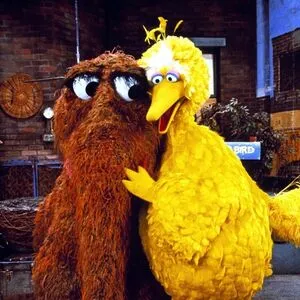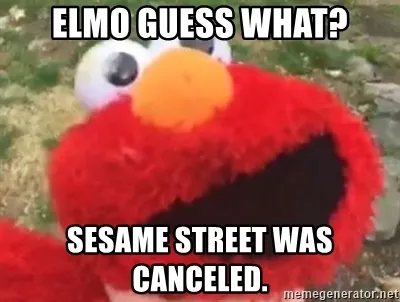Note: This is an alternate history thought experiment in which I speculate about a historical event occurring differently. Each point in history can unfold in different ways. Your speculation may vary.
On December 8, 2019 Caroll Spinney, original Muppeteer of Big Bird and other Sesame Street characters, died. For many years before his death Spinney would recount, and NASA has confirmed, Spinney was once a possible candidate for being on the Challenger space shuttle which exploded in 1986.
So, what if Caroll Spinney had been on the Challenger when it exploded? Let's say in an alternate history someone high up in NASA had the clout and wanted Big Bird to go into space more than anything else. Let's call this the "Dead Big Bird" timeline for the obvious reason.
In an alternate January 28, 1986 virtually everything is the same as in "our" timeline. Cold conditions, countdown, explosion, ect. Except in this timeline Sharon Christa McAuliff is in her New Hampshire classroom and Caroll Spinney is a Payload Specialist aboard the Challenger. The new Big Bird costume, specially designed by a team of material scientists and technicians, is stored in cargo. A costume that will never be used as planned.
A few years later in this alternate timeline an infamous rhyme can be heard in school playgrounds:
Big Bird! Big Bird! Ready to fly?
How many seconds until you die?
Seventy-three until your doom.
Then your rocket goes KA-BOOM!
In the "Dead Big Bird" timeline Caroll Spinney receives the invitation from NASA in 1984 just like in "our" timeline but more favorable talks with the appropriate representatives of the Children's Television Workshop and anybody else that would need to approve the agreement on Spinney's side happen. Spinney becomes the first member of the Space Flight Participant Program.
I can't find a reference to exactly when in 1984 Spinney got the initial letter asking if he'd be interested in going into space. The Teacher in Space Project was announced by President Reagan in late August 1984 so I'll assume by default Spinney was invited around early July 1984.
I think it's most likely that the sixteenth season of Sesame Street in the "Dead Big Bird" timeline would be virtually the same as in "our" timeline. Possibly a portion of Episode #2001 would be different as an Arthur C. Clarke reference for the adults watching with their kids.
To accommodate Spinney having to be away temporarily from Sesame Street for training and being in space the show develops a story arc for season seventeen to account for Big Bird's absence. In "our" timeline season seventeen of Sesame Street only had three entirely new episodes: Episode #2096, Episode #2097 and Episode #2098. In the "Dead Big Bird" timeline the plan would have been to also have three entirely new episodes and just make all the other episodes for season seventeen compiled from previous season clips that didn't feature Big Bird. Other Spinney characters such as Oscar the Grouch could be featured in season seventeen episodes because the young target audience wouldn't question that.
The traditionally November season premiere episode of Sesame Street in the "Dead Big Bird" timeline is postponed to late January 1986 to take full advantage of media interest in Spinney's involvement in the upcoming space mission. Interestingly, the scenario of Big Bird being away from Seasme Street at this time means the show puts off the Mr. Snuffleupagus reveal to the adult characters. In the "Dead Big Bird" timeline the adults on Sesame Street never find out Snuffy is real and not Big Bird's imaginary friend. Season sixteen's Episode #1966 starts to move in that direction with Linda, Maria and Gordon saying they believe Mr. Snuffleupagus exists without ever having seen him but the canonicity would never be established.

Image Source: muppet.fandom.com
In the "Dead Big Bird" timeline season seventeen's first episode is aired on January 24, 1986. Elmo tries to find Big Bird. The adults explain to Elmo that Big Bird went to NASA and they explain to Elmo what NASA is. Elmo misses Big Bird but the adults assure Elmo that Big Bird will be coming back soon right after he becomes the first Big Bird in space. Later in the episode a video tape from Big Bird comes in the mail for the gang.
On the second episode aired January 27, 1986 Grover gets the idea that Sesame Street should have its own space program. The episode has the characters working together to make a mock mission control room. Really it's school desks and a TV on a stand that can be used to play a video game about space. The episode teaches lessons about authority, cooperation and responsibility.
Depending on timezone and local station scheduling not every child in the "Dead Big Bird" timeline had a chance to see the third episode of Sesame Street's seventeenth season. In the "Dead Big Bird" timeline I wouldn't have gotten the chance to have seen it so I really can't say much about the episode. Either you saw the last Sesame Street episode or you didn't. Right after the Challenger explosion Sesame Street went into immediate hiatus and Big Bird merchandise was removed from store shelves. That final episode in the "Dead Big Bird" timeline, like the Sesame Street episode featuring Margaret Hamilton, was never reran and became lost media. The VHS tapes that were sent to thousands of schools for the older children about the behind the scenes at NASA with Big Bird became a morbid collector's item.

Image Source: memegenerator.net
It was obvious to most that the Big Bird character had to be retired after Caroll Spinney died in the Challenger explosion. Not everyone would agree with that though and had reasons for wanting to keep Big Bird as an active character. Many based on nostalgia and others to promote a cause. Some on the right wing saw this as an opportunity to promote religion on the show. They argued Big Bird could take on the role of a guardian angle-type spirit. A popular left wing idea was simply to have Big Bird survive the Challenger explosion. Big Bird, according to their narrative, tried to save the other crew members but couldn't. Failing that Big Bird jumped out of the shuttle and glided to safety. Big Bird could return to Sesame Street with the message that all the money that went to the shuttle program should have gone to help the people of the world.
There would be no reprieve for Big Bird. Sesame Street had already justifiably established that death was permanent after Will Lee, who played the character Mr. Hooper, died in 1982. If Sesame Street were to ever come back from hiatus in the "Dead Big Bird" timeline it would have been rebranded so much it really wouldn't have been Sesame Street anymore. Caroll Spinney dying in the Challenger explosion would have effectively canceled Sesame Street back in 1986.
Earlier in this post I referred to the reveal of Mr. Snuffleupagus being real. In "our" timeline this is actually a very significant point in the show's history. Between seasons three and sixteen of Sesame Street Big Bird trying to prove Snuffy's existence to his adult friends had become something of a running gag. This actually turned out to be a problem that had to be stopped. According to the Muppet Wiki by the mid-1980s the writers began to realize that the show might be sending the wrong message to kids that adults wouldn't believe them if they came forward with truthful accusations of child abuse or pedophilia. If Sesame Street had prioritized Big Bird going into space and put off the Snuffy reveal until Big Bird's return, which wouldn't have happened, there could be an unknown number of abusers and perpetrators in the "Dead Big Bird" timeline who went unreported that were found out in "our" timeline.
Even with the death of a major television icon I think Caroll Spinney dying in the Challenger explosion wouldn't have meant the end to all future shuttle missions. Space is too valuable of a resource to not exploit. The United States would need weather satellite data just as much as it needs that data from the spy satellites that don't officially exist.
After focusing on Sesame Street so much let's wrap this up with Punky Brewster. In the episode "Accidents Happen" Punky shows up as an astronaut for a class presentation on what she wants to be when she grows up. After seeing this all her fellow classmates get excited and decide they also want to become astronauts. Seeing their enthusiasm the teacher announces next week he'll bring a TV into class so they can all watch a live space launch. This one will be special because a teacher is going into space...You see where this is going. After seeing the Challenger explode Punky still wants to be an astronaut but her classmates now think that's a crazy idea.
While the viewpoint of those classmates shouldn't be just ignored I would like to think that even if Caroll Spinney had died in the challenger explosion most children already interested in science and technology wouldn't be discouraged. At times science can be dangerous but the knowledge and advancement that can possibly be gained outweighs the risk.
The internet as we know it would exist in the "Dead Big Bird" timeline. There would be forum discussions debating whether Snuffy was imaginary or real since Sesame Street never had a chance to make the existence canon. In the mid to late '90s images of Big Bird and the other Sesame Street characters could be found. Eventually clips from some of the sixteen seasons of Sesame Street would be on video sharing sites for adults and children who never got to see Sesame Street to find.
Who knows? Maybe, just maybe, that huge yellow bird wouldn't be remembered just as an icon destroyed in a failed space launch. Maybe the new generation that discovers Big Bird for the first time watching YouTube clips would also see Big Bird for what the icon was meant to be. For why Big Bird was supposed to go to space in the first place. To inspire the next generation to reach for the stars.




